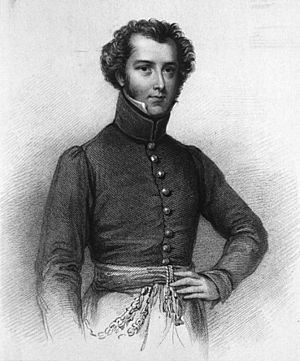Alexander Gordon Laing facts for kids
Quick facts for kids
Alexander Gordon Laing
|
|
|---|---|

Journalist and explorer
|
|
| Born | 27 December 1794 |
| Died | 26 September 1826 (aged 31) Araouane, Pashalik of Timbuktu
|
| Alma mater | University of Edinburgh |
Alexander Gordon Laing was a brave Scottish explorer. He lived from 1794 to 1826. He is famous for being the first European to reach the ancient city of Timbuktu. He arrived there in August 1826, after a long journey across the desert. Sadly, he was killed just a few weeks after leaving Timbuktu.
Contents
Early Life and Education
Alexander Gordon Laing was born in Edinburgh, Scotland, in 1794. His father, William Laing, was a teacher. He taught Alexander at home. Alexander also studied at the University of Edinburgh. In 1811, he moved to Barbados. There, he worked for his uncle, Colonel Gabriel Gordon.
Military Adventures
Laing joined the army in 1813. He became an ensign, which is a junior officer rank. He was promoted to lieutenant in 1815. Later, he joined the 2nd West India Regiment. In 1822, he became a captain in the Royal African Colonial Corps.
While in Sierra Leone, he was sent on important missions. The governor, Sir Charles MacCarthy, asked him to help. Laing's goals were to start trade and stop the slave trade. He traveled to the Mandingo country. He also visited Falaba, the capital of Solimana. There, he found the source of the Rokel River.
He tried to find the source of the Niger River. Local people stopped him, but he got close. In 1824, he became a major in Africa. He also fought in the Ashanti War of 1823-24. He brought news of Sir Charles MacCarthy's death back to England. In 1825, Laing published a book about his travels. It was called Travels in the Timannee, Kooranko and Soolima Countries, in Western Africa.
The Journey to Timbuktu
Laing believed he had found the source of the Niger River. He wanted to follow the river all the way to the sea. Important people like Joseph Banks supported his plan. They hoped he would find the famous city of Timbuktu.
In 1825, the government asked Captain Laing to explore the Niger River area. He left England in February 1825. In Tripoli, he married Emma Warrington on July 14. Just two days later, he began his journey across the Sahara desert.
He traveled through Ghadames and In Salah. In In Salah, he met some Tuareg people who welcomed him. On January 10, 1826, he left Tuat. He headed into the desert towards Timbuktu.
His journey was very difficult. Letters he wrote in May and July told of his struggles. He suffered from fever. His group was also attacked by another group of Tuareg. Laing was badly wounded in 24 places. He lost his right hand.
With another survivor, he reached Sidi Al Muktar. He had lost everything. He joined another group and finally reached Timbuktu. This made him the first European to cross the Sahara from north to south.
Laing arrived in Timbuktu on August 18, 1826. He wrote a letter on September 21. He said his situation was dangerous. The local ruler, Bello, was not friendly. Laing planned to leave Timbuktu in three days.
Sadly, no more news came from him. Later, people found out what happened. He left Timbuktu as planned. He was killed during an attack on or around September 26, 1826.
What Happened Next
Laing's important papers and journals were never found. His father-in-law, Hanmer Warrington, thought the French might have taken them. However, there was no proof of this.
Two years after Laing, another explorer named René Caillié reached Timbuktu. Caillié returned alive. He won a big prize of 10,000 francs for his achievement. Both Laing and Caillié received the Gold Medal from the Société de Géographie in 1830.
In 1903, the French government honored Laing. They placed a special plaque on the house where he stayed in Timbuktu. This house is in the Djingareiber area. It was declared a national heritage site in 1992.
See Also
 In Spanish: Alexander Gordon Laing para niños
In Spanish: Alexander Gordon Laing para niños



